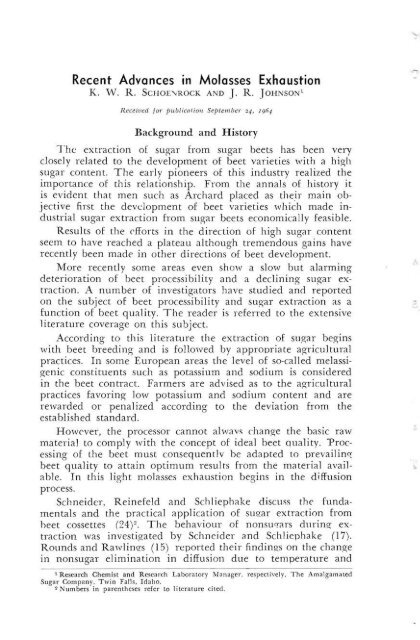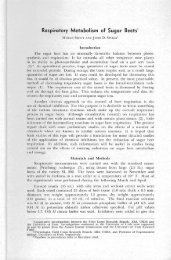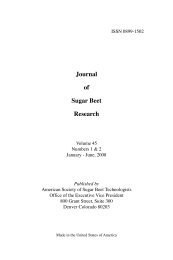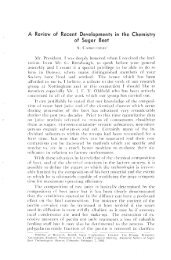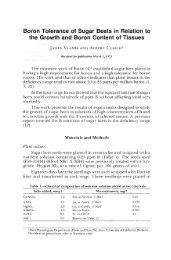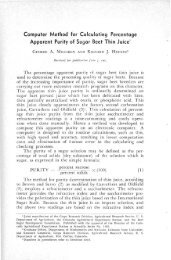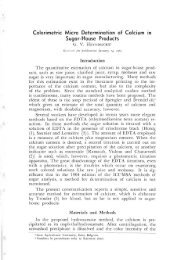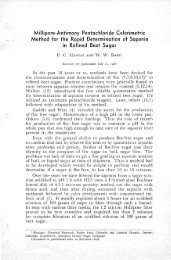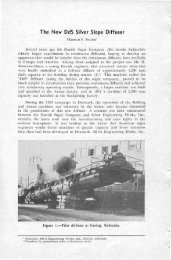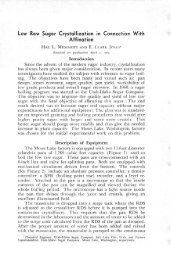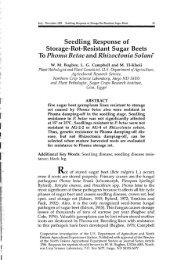Recent Advances in Molasses Exhaustion - Vol
Recent Advances in Molasses Exhaustion - Vol
Recent Advances in Molasses Exhaustion - Vol
Create successful ePaper yourself
Turn your PDF publications into a flip-book with our unique Google optimized e-Paper software.
664 JOIJRNAL OF THE A. S. S. B. T.<br />
crystallization of sucrose from weakly supersaturated solutions<br />
are based on pure solutions its value might well extend <strong>in</strong>to the<br />
range of impure solutions. Their observations with damaged and<br />
so-called healed crystal surfaces may expla<strong>in</strong> <strong>in</strong> part the reason<br />
for Carolan's (3) failure to exhaust molasses when start<strong>in</strong>g with<br />
a higher purity mother liquor (compare chapter 7, Tables 7<br />
and 8 with chapter 6, Tables 5 and 6) <strong>in</strong> spite of sufficiently<br />
high supersaturations.<br />
Wagnerowski et al. (30); Pidoux (14); and Vavr<strong>in</strong>ecz (28)<br />
among others reviewed the solubility of pure sucrose <strong>in</strong> "vater.<br />
A large share of attention has been focused on the <strong>in</strong>fluence<br />
of the various nonsugars represented <strong>in</strong> beet liquo'rs upon the<br />
solubility of sucrose (salt<strong>in</strong>g out effect). In a series of publications<br />
Schneider et al. (18, 19,20) reported on sucrose solubility<br />
and crystallization as a function of <strong>in</strong>dividual nonsugar fractions.<br />
They also published their work on the <strong>in</strong>fluence of beet nonsugars<br />
on molasses fonnation (2 1,22,23). Mantovani <strong>in</strong>vestigated<br />
the <strong>in</strong>dividual effect of potassium chloride (9), beta<strong>in</strong>e (10) and<br />
raff<strong>in</strong>ose (l]) on sucrose so lubility and crystallization. He found<br />
a significant salt<strong>in</strong>g out effect for potassium chloride and a small<br />
decrease <strong>in</strong> Sllcrose solubility with either beta<strong>in</strong>e or raff<strong>in</strong>ose.<br />
The results Mantovani obta<strong>in</strong>ed with raff<strong>in</strong>ose were confirmed<br />
<strong>in</strong> our studies. Accord<strong>in</strong>g to Mantovani sucrose crystallization<br />
was only impaired to the extent of the salt<strong>in</strong>g out effect<br />
for potassium chloride or beta<strong>in</strong>e while raff<strong>in</strong>ose <strong>in</strong>hibited sucrose<br />
crystallization to a much larger extent than its salt<strong>in</strong>g out effect<br />
would justify. Carolan (3) essentially confi,rmed Mantovani's<br />
f<strong>in</strong>d<strong>in</strong>gs for potassium chloride and beta<strong>in</strong>e, respectively, alone<br />
but found a decrease <strong>in</strong> sucrose crystallization for a comb<strong>in</strong>ation<br />
of the two ma<strong>in</strong> nonsugars <strong>in</strong> molasses <strong>in</strong> excess of the comb<strong>in</strong>ed<br />
salt<strong>in</strong>g out effect.<br />
Grut (6) described a method for the determ<strong>in</strong>ation of molasses<br />
exhaustion. \tVagnerowski and coworkers (29) proposed<br />
a simple laboratory method for the estimation of specific sucrose<br />
solubility <strong>in</strong> pure and impure systems. In subsequent publications<br />
(31, 32, 33) vVagnerowski et al. proposed a system for<br />
evaluat<strong>in</strong>g and guid<strong>in</strong>g molasses exhaustion under optimum<br />
conditions. Dobrzycki (4) reported also on these f<strong>in</strong>d<strong>in</strong>gs.<br />
Development and Summary<br />
Inconsistencies <strong>in</strong> low' purity crystall ization on a factory level<br />
prompted the authors to suspect a variable deviation of sucrose<br />
solubility from the values <strong>in</strong> established solubility tables.<br />
The method of vVagnerowski et al. appeared to be well suited<br />
to allow the quick and simple determ<strong>in</strong>ation of sucrose solubility
I<br />
J <br />
VOl.. 13, -:-':0. 8, ]ANl",\RY 1966<br />
665<br />
<strong>in</strong> specific low purity liquors. The basic f<strong>in</strong>d<strong>in</strong>gs of Wagnerowski<br />
et al. may be summarized as fo llows:<br />
1. The saturation equilibrium for sucrose <strong>in</strong> low purity<br />
liquors is approached <strong>in</strong> about two hours. Schneider<br />
and coworkers have published similar results.<br />
2. The coefficient of saturation 3 rema<strong>in</strong>s constant under<br />
temperature change for a given nonsugar/ water ratio.<br />
This discovery has been credited to Wiklund (34).<br />
3. lor low purity liquors with a nonsugar/ water ratio><br />
1.5 the coefficient of saturation is a l<strong>in</strong>ear function of<br />
the nonsugar/ water ratio.<br />
These f<strong>in</strong>d<strong>in</strong>gs were basically confirmed by our work. Solubility<br />
diagrams such as proposed by vVagnerowski et al. were<br />
prepared from time to time to see whether a shift <strong>in</strong> sucrose<br />
solubility did occur as campaign advanced. Sucrose solubility<br />
<strong>in</strong> molasses from different lactories as well as sucrose solubility<br />
<strong>in</strong> molasses from different process<strong>in</strong>g periods was determ<strong>in</strong>ed and<br />
compared aga<strong>in</strong>st each other, as well as aga<strong>in</strong>st the values from<br />
established solubility tables. It ·was apparent that differences <strong>in</strong><br />
sucrose solubility did occur between different beet liquors. These<br />
differences were however, relatively small for the test program<br />
thus far. A calculated least square straight l<strong>in</strong>e relationship between<br />
the coefficient of saturation and the nunsugar/ water ratio<br />
represent<strong>in</strong>g all soIl! bility values thus far established appears to<br />
suffice for normal factory operation.<br />
Observed differences between determ<strong>in</strong>ed values and values<br />
taken hom established solubility tables were however very large.<br />
An accurate knowledge of actual solubility m<strong>in</strong>imizes the chance<br />
for either undersaturation or excessive supersaturation dur<strong>in</strong>g<br />
low raw massecuite cur<strong>in</strong>g. Dilution and reheat<strong>in</strong>g dur<strong>in</strong>g the<br />
various crystallizer stages may be scheduled to confoqn with the<br />
actual solubility range. This will m<strong>in</strong>imize danger of redissolv<strong>in</strong>g<br />
already crystallized sugar or of <strong>in</strong>adequate exhaustion of the<br />
molasses.<br />
Alignment charts arc presented which show the relationship<br />
between brix, purity, temperature and supersaturation on the<br />
one hand and the relationship between massecuite brix, purity,<br />
f<strong>in</strong>al nonsugar/ water ration, pan size and total water addition<br />
on the other hand. Additional alignment charts may aid operators<br />
to further optimize the operation of the entire 10"" raw side by<br />
know<strong>in</strong>g the total available time for operation under a specific<br />
set of conditions.<br />
3 The coefficient of saturation expresses the ratio of disso1 ved sugar between impure<br />
and pure solutions at the same temperature and at saturatioll.
666 ] OURNAL OF THE A. S. S. B. T.<br />
A large number of complete crystallizer cycles were cont<strong>in</strong>uously<br />
sampled. Viscosity, brix and purity were determ<strong>in</strong>ed<br />
on the massecuite and the respective mother liquor throughout<br />
the cycle to determ<strong>in</strong>e the rate of crystallization. The cumulative<br />
crystallization rate l was found to be a log function of the log<br />
ot time. Only the slope varied with a change <strong>in</strong> the conditions.<br />
In another phase of this <strong>in</strong>vestigation the role of viscosity<br />
<strong>in</strong> low raw crystallization was studied. Op<strong>in</strong>ions are somewhat<br />
divided on the relationship between viscosity and rate of crystallization.<br />
For all prac tica l purposes <strong>in</strong> factory operation, however,<br />
viscosity is the controll<strong>in</strong>g [actor <strong>in</strong> low raw massecuite cur<strong>in</strong>g.<br />
For the practitioner it is of no immedia te concern whether<br />
viscosity effects the crystallization rate directly or <strong>in</strong>directly. Viscosity<br />
dictates the cool<strong>in</strong>g rate, required dilution of mother<br />
liquor, and the conditions for- and results of-f<strong>in</strong>al purg<strong>in</strong>g<br />
on the low raw side. A thorough understand<strong>in</strong>g of the role of<br />
viscosity <strong>in</strong> crystallization is therefore vital.<br />
<strong>Recent</strong>ly Schneider, Schliephake and Klimek (25) reported<br />
their f<strong>in</strong>d<strong>in</strong>gs on the viscosity of pure sucrose solutions. Tikhomiroff,<br />
Pidoux and Filippi evaluated the effect of viscosity<br />
on crystal formation <strong>in</strong> super-saturated aqeous sucrose solutions<br />
(26). Wagnerowski, Dabrowska and Dabrovvski (33) <strong>in</strong>vestigated<br />
the relationship between foam<strong>in</strong>g, viscosity and molasses exhaustion.<br />
Pidoux (13) made a significant contribution when he<br />
developed a simple formula for express<strong>in</strong>g the temperature/ viscosity<br />
relationship <strong>in</strong> sucrose sol u tions. H is discovery has been<br />
applied to our work with molasses exhaustion. In so do<strong>in</strong>g it<br />
has been possible to predict proper viscosities for purg<strong>in</strong>g by<br />
adjust<strong>in</strong>g conditions to conform with optimum results. Massecuite<br />
as well as m other liquor viscosity was found to be a l<strong>in</strong>ear function<br />
of temperature although air entra<strong>in</strong>ment and nucleation<br />
of f<strong>in</strong>es may be responsible for certa<strong>in</strong> dev iations. In any event,<br />
cool<strong>in</strong>g and dilution rates may be progTammed on the basis of<br />
anticipated viscosities rather than solely on the immediate power<br />
requirements of the crystallizer.<br />
Experimental Methods<br />
Solubility determ<strong>in</strong>ations were carried out accord<strong>in</strong>g to th e<br />
procedures suggested by vVagnerowski et al . . \. fully jacketed three<br />
neck flask with one liter capacity was used for our determ<strong>in</strong>ations.<br />
The center neck received the stuff<strong>in</strong>g box with stirrer<br />
d Cumula tive crystalliza ti on rate is here expressed as % sugar crystaJlized per m<strong>in</strong>ule<br />
on LO lal sug'ar <strong>in</strong> orig<strong>in</strong>al mother liquor and disregard<strong>in</strong>g available cr)stal surface area.
VOL. 13, No.8, JANUARY 1966<br />
667<br />
assembly. The two side necks were used for a reflux condenser<br />
and a thermometer, respectively. Constant temperature water<br />
was circulated through the jacket of the flask. The flask was<br />
placed <strong>in</strong> a full size electric heat<strong>in</strong>g mantle to m<strong>in</strong>imize radiation<br />
loss, and to support the output of the constant temperature<br />
water bath if needed. Temperature of recirculation water was<br />
controlled through a thermistor regulated constal1l temperature<br />
water bath.<br />
The flask was charged with the appropriate molasses sample<br />
of a predeterm<strong>in</strong>ed nonsugar/ water ratio. Temperature was ma<strong>in</strong>ta<strong>in</strong>ed<br />
at ± 0.0 1 ac. When thermal equilibrium was reached an<br />
adequate amoul1l of coarse sugar, - 16 + 34 mesh, was added<br />
to provide a safe excess of sugar at saturation. The molasses/sugar<br />
mixture was then agitated for at least two hours at the test<br />
temperature. The necessary high nonsugar/ water ratio <strong>in</strong> the<br />
molasses was either obta<strong>in</strong>ed by distill<strong>in</strong>g off excess water from<br />
normal molasses or by sampl<strong>in</strong>g a crystallizer early <strong>in</strong> the cycle<br />
when nonsugar/ water ratios were still sufficiently high to avoid<br />
evaporation of excess water. The latter method was f<strong>in</strong>ally adopted<br />
s<strong>in</strong>ce a host of problems was associated with the former procedure.<br />
A Carver Press fitted with a home made jacketed cyl<strong>in</strong>der<br />
assembly was u sed to separate the mother liquor from excess<br />
crystals. The Carver press assembly was equipped 'with controlled<br />
electric heat<strong>in</strong>g platens. Constant temperature water from the<br />
water bath was also circulated through the jacket of the cyl<strong>in</strong>der<br />
to keep the massecuite a t temperature equilibrium dur<strong>in</strong>g the<br />
press<strong>in</strong>g operation. The heavil y supported screen<strong>in</strong>g section<br />
allowed the use of any filter<strong>in</strong>g media. Tightly woven l<strong>in</strong>en cloth<br />
was normally employed as a primary filter. The expressed mother<br />
liquor 'was collec ted <strong>in</strong> a jar and aliquot parts were used for<br />
the purity and viscosity determ<strong>in</strong>ations. Viscosity was ..determ<strong>in</strong>ed<br />
with the Brookfield-Synchro-Lectric Model RVT viscometer and<br />
purities were determ<strong>in</strong>ed via the s<strong>in</strong>gle acid true purity method.<br />
Results and Discussion<br />
The differences <strong>in</strong> solubility between tbe values of Grut;<br />
Brown & Nees; and Tw<strong>in</strong> Falls material for the 62-63 campaign<br />
are illustrated <strong>in</strong> Figure 1. It is easily seeri that tbe Tw<strong>in</strong> Falls<br />
material dissolves more sugar for a given n onsugar/ wa ter ratio<br />
than either the Grut or Brown & i'\ees values 'would <strong>in</strong>dica te.<br />
The solubility values 'were applied to an actual crystallizer run<br />
to show the difference <strong>in</strong> supersaturation. Figure 2 illustrates<br />
the difference <strong>in</strong> supersaturation when us<strong>in</strong>g either Grut's solubility<br />
values and actually determ<strong>in</strong>ed solubilities respectively.
VOL. 13, No. 8, JANUARY 1966<br />
75.0<br />
755<br />
76.0<br />
76.5<br />
77.0<br />
77.5<br />
78.0<br />
78.5<br />
79.0<br />
2.6<br />
24<br />
2 .3<br />
22<br />
79.5<br />
NS/ W<br />
In <strong>Molasses</strong><br />
60.0<br />
60.5<br />
1.075<br />
1.060<br />
1.065<br />
/<br />
/(090<br />
l.095<br />
1100<br />
1.105<br />
1.110<br />
/<br />
/<br />
1.114<br />
SATP 81.0 K k<br />
J<br />
1075<br />
LOBO<br />
1.085<br />
1.090<br />
1.095<br />
1.100<br />
1.105<br />
l.1I0<br />
Brix<br />
96.0<br />
95.5<br />
95.0<br />
94.5<br />
94.0<br />
935<br />
93.0<br />
92.5<br />
920<br />
100<br />
9.5<br />
9.0 /<br />
/<br />
/6.5<br />
6.0<br />
7.5<br />
7.0<br />
6 .5<br />
6 .0<br />
5.5<br />
5 .0<br />
45<br />
4 .0<br />
3 .5<br />
100<br />
9.5<br />
9 .0<br />
8 .5<br />
8 .<br />
7 .5<br />
7 . 0<br />
6 .5<br />
6 .0<br />
5.5<br />
5 .0<br />
4 .5<br />
4 .0<br />
3 .5<br />
671<br />
700<br />
650 1500<br />
600<br />
550 '1400<br />
500<br />
!l50 1300<br />
400<br />
350<br />
1200<br />
300 1100<br />
250<br />
200<br />
150<br />
125<br />
900<br />
BOO<br />
3.0<br />
Gal Water per Totol Water<br />
700<br />
Pon <strong>Vol</strong>ume<br />
Ton Fitlmoss to Crystallizer <strong>in</strong> Cu Ft<br />
Figure 5.-Nomograph show<strong>in</strong>g the relationship between pan size, pan<br />
RDS, pan SATP, desired nonsugar/ water <strong>in</strong> molasses and required total<br />
water addition <strong>in</strong> gallons to the crysta Hizer.<br />
specific gravity are small and may be neglected.<br />
1000<br />
A simplified nomograph may be used accord<strong>in</strong>g to Figure 6<br />
by stabiliz<strong>in</strong>g the pan size and the nonsugar/ water ratio <strong>in</strong> f<strong>in</strong>al<br />
molasses. For most factories this latter alignment chart is<br />
adequate.<br />
In the example shovvo ih Figure 5 a straight l<strong>in</strong>e is projected<br />
between the s<strong>in</strong>gle acid true purity of the massecuite at pan<br />
drop (<strong>in</strong> this case 77.5% ) on the far left scale through the<br />
selected nonsugar/water ratio <strong>in</strong> molasses (<strong>in</strong> this case 2.5), to<br />
obta<strong>in</strong> a K value of 1.09. A like K value is found on the adjacent<br />
K, scale and connected via a straight l<strong>in</strong>e over the determ<strong>in</strong>ed<br />
massecuite RDS (<strong>in</strong> this case 95 °) to f<strong>in</strong>d a water addition of<br />
8.5 gallons/ tons massecuite. This value of 8.5 may be connected<br />
from the second scale graduated <strong>in</strong> gallons water/ ton fillmass<br />
with the pan volume on the scale at the far right (<strong>in</strong> this case<br />
1200 cu ft) <strong>in</strong> the third part of the nomograph by a straight<br />
l<strong>in</strong>e to show a total water addition of 480 gallons. Or the value<br />
of 8.5 may be multiplied mentally with the total tons of fillmass<br />
at pan drop to obta<strong>in</strong> total water addition.
678 JOURNAL OF THE A. S. S. B. T.<br />
4. Fstablish characteristic composition of mother liquor at<br />
pan drop. This composition is relatively specific for that<br />
particular factory and need be re-established only if a<br />
deviation from normal boil<strong>in</strong>g practices occur.<br />
5. Decide on the f<strong>in</strong>al nonsugar/water ratio <strong>in</strong> molasses. An<br />
optimum ratio of 2.5 is recommended for most operations.<br />
6. Consult Figure 9 to establish the maximum time available<br />
for pan boil<strong>in</strong>g. If the pan size is consistent use Figure<br />
10. To ma<strong>in</strong>ta<strong>in</strong> uniformity stick to thc time schedule<br />
thusly found.<br />
7. Aga<strong>in</strong> consult Figure 9 or 10 to establish total available<br />
crystallizer time and adhere to the found value.<br />
8. Resolve the lowest temperature to be reached dur<strong>in</strong>g the<br />
crystallizer cool<strong>in</strong>g cycle. If the operation under 7 projects<br />
adequate time e.g. L:J hours or more than the massecuite<br />
may be cooled as low as 40°C, provided that the reheat<strong>in</strong>g<br />
may be accomplished <strong>in</strong> the mixer rather than<br />
<strong>in</strong> the crystallizer. However, if the total cool<strong>in</strong>g time<br />
is limited to 12 hours or less, then do not cool below 50°C.<br />
9. (a) Subtract from the total time as found under 7 the<br />
comb<strong>in</strong>ed time needed for fill<strong>in</strong>g and dra<strong>in</strong><strong>in</strong>g of the<br />
crystallizer to arrive at a fixed cool<strong>in</strong>g time.<br />
(b) Subtract the value established under 8 (lowest temperature)<br />
from the temperature of the massecuite <strong>in</strong> °C at<br />
pan drop to fix the temperature spread <strong>in</strong> °C.<br />
10. Project an imag<strong>in</strong>ary straight l<strong>in</strong>e <strong>in</strong> Figure II between<br />
the values as found under 9a and b respectively to establish<br />
a fixed cool<strong>in</strong>g rate.<br />
11. Obta<strong>in</strong> pan RDS, pan s<strong>in</strong>gle acid true purity and total<br />
pan size from the laboratory. Together with the value<br />
resolved under 5 (nonsugar/ water ratio <strong>in</strong> molasses) determ<strong>in</strong>e<br />
total water addition to the crystallizer b'jl consu1t<strong>in</strong>.g<br />
Figure 5. If pan size and nonsugar/ water ratios<br />
<strong>in</strong> molasses rema<strong>in</strong> constant for every strike use the simple<br />
nomograph <strong>in</strong> Figure 6.<br />
12. Determ<strong>in</strong>e supersaturation at pan drop by us<strong>in</strong>g values<br />
derived as under 4 (mother liquor brix and % purity)<br />
<strong>in</strong> Figure 7. If supersaturation thusly determ<strong>in</strong>ed does<br />
not exceed 1.2, do not add water until the Q:radual viscosity<br />
<strong>in</strong>crease demands dilution. For crystallizer with 12 or<br />
more hours cool<strong>in</strong>g time the ,vater addition need not<br />
beg<strong>in</strong> above 70°C. The rate of water dilution should be<br />
held as 10'" as total rema<strong>in</strong><strong>in</strong>g crystallizer time permits.<br />
Total water must dissipate <strong>in</strong> the massecuite before the<br />
fillmass has to be dumped. This is an area where <strong>in</strong>di


